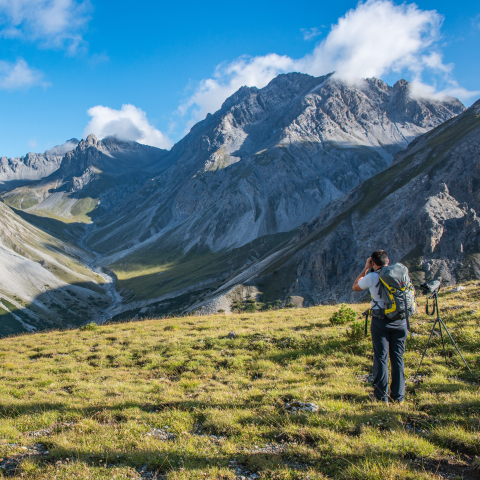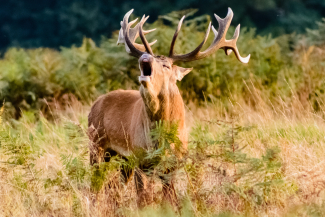Swiss National Park.
Out and About with the Park Ranger

It is a balmy day in September, in the middle of the stag rutting season in the Swiss National Park. All around, stags are vying for the favour of the females – a spectacle that attracts many onlookers. Fadri Bott expects a large number of guests today. The National Park ranger is currently out in Val Mingèr, a wild valley in the Lower and Upper Engadine and in the National Park in Val Müstair. The first glimpses of yellow are shimmering in the forest, the alpine meadows are looking paler. Clear signs that winter is on its way. The heavy snow will soon be here, then the nature in the park will treat itself to its hibernation and a break from the around 120,000 guests who enjoy the 100 kilometre-long network of hiking routes in summer and autumn.

A Boyhood Dream Comes True
Fadri Bott can normally be found on the other side of the park in the Ofen Pass area, his home. There, in Valchava, right on the border with Northern Italy, where the 51-year-old was born and raised, he was born into the profession of park ranger. «I already knew in nursery that I wanted to work in the National Park,» he says. At 22 years of age, he became one of the youngest park rangers in the Swiss National Park, and has led the eight-person park ranger team since 2011. His boyhood dream was realised.
Fadri Bott and his colleagues have some intense summer months behind them. The rangers spend up to 13 hours a day in the park at peak times. In May, the season begins for them with maintenance: path and border markers are replaced and bridges rebuilt, as the masses of snow, particularly avalanches, leave their mark. By mid-June, the rangers, helped by interns, set up around 150 photo traps in the Ofen Pass region, which they then collect again before winter sets in. On foot, naturally. Other animals are fitted with GPS transmitters. These include red deer, chamois, ibexes and foxes – all marked by the park rangers.
It’s a Ranger Thing
There have been supervisors in the Swiss National Park ever since it was founded in 1914. They were initially border guards, who ensured law and order. Today, the role of National Park ranger is mostly performed by qualified tradespeople. Anyone who talks to Fadri Bott will quickly lose the widespread, romantic idea that national park rangers spend the whole day observing animals. It is much more than that. The eight park rangers, who are employed all year round, keep watch over stocks of wildlife and plants, maintain the National Park infrastructure and act as contact persons for guests. Their support with research is becoming more and more important. Each year, around 70 scientific research projects investigate and document the natural processes and changes in the National Park.

Eye to Eye with the Animals
Meanwhile, in the idyllic Val Mingèr, whistling marmots have joined in the bellowing song of the stags. An animalistic concert. On the opposite side of Sur il Foss, a saddle at 2,317 metres, numerous stags fervently attempt to win round the hinds. Even after 30 years as a park ranger, the deer rut is still a special experience for Fadri Bott. Bearded vultures, ibexes, chamois, wolves and bears – he’s seen them all. But what really warms Fadri Bott’s heart is when he discovers the first marmot pups at the beginning of July and can observe them. He once witnessed the mother grab the cute little rodents by the scruff of the neck and take them to safety in her burrow. «Simply impressive,» he says.
Hibernating like the Marmots
Another natural spectacle awaits in October, when the larch forests turn a wonderful golden colour. This is the final blaze of colour before the winter. Then the animal world slowly begins its hibernation. And the park rangers do the same. «In winter, we’re almost like the marmots: we replenish our energy for the intense summer months and finish work in the office and workshop. We also go out in winter to do counts, observe the wildlife and perform supervisory work, sometimes at minus 30 degrees Celsius,» says Fadri Bott. But it is still September. A balmy autumn day. The first visitors reach the plateau of Sur il Foss and observe the bellowing red deer. Fadri Bott sets up his telescope. Much to the delight of the guests, who are able to catch a unique glimpse of the exciting scenery at the foot of Piz Mingèr through the lens. Fadri Bott is not just a ranger, but also a host.
Did you know...?
The Swiss National Park, with an area of 170 km2, is Switzerland’s largest nature reserve. The strictly protected area lies in the Engadine/Münster valley and comprises alpine terrain at 1,400 to 3,200 m above sea level. The founding of the Swiss National Park in 1914 was a milestone in the history of nature protection. It was the first national park in the Alps and Central Europe and is known for its abundance of alpine animals and plants in an almost untouched natural landscape.